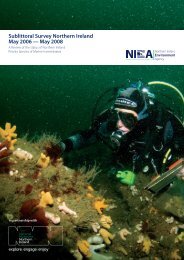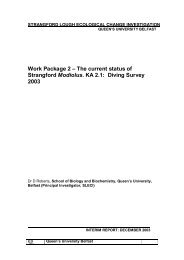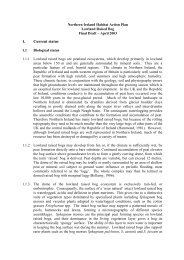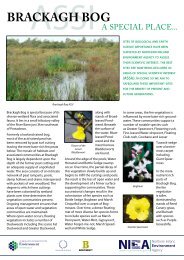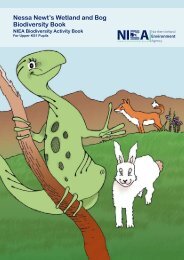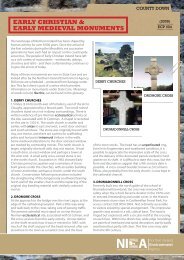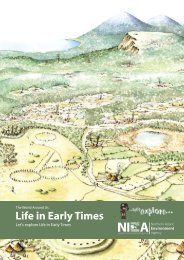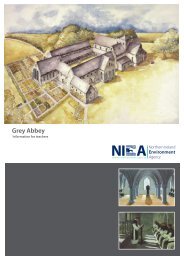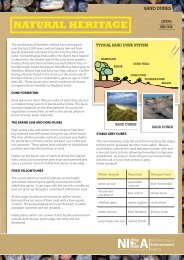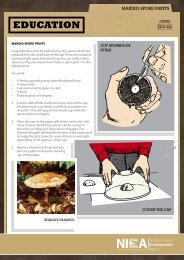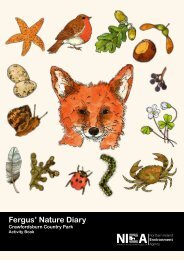Binevenagh Nature Reserve Information for Teachers (.PDF 0.97
Binevenagh Nature Reserve Information for Teachers (.PDF 0.97
Binevenagh Nature Reserve Information for Teachers (.PDF 0.97
You also want an ePaper? Increase the reach of your titles
YUMPU automatically turns print PDFs into web optimized ePapers that Google loves.
<strong>Binevenagh</strong> <strong>Nature</strong> <strong>Reserve</strong><br />
Fungi<br />
Mushrooms are examples of a group of living things<br />
called fungi. They are not plants because they do not<br />
photosynthesise. They are called decomposers because<br />
they live by breaking down dead material from plants<br />
and animals. This is a very important process as they help<br />
recycle the minerals back into the soil allowing plants<br />
to continue growing. The reserve is of international<br />
importance <strong>for</strong> wax cap mushrooms. They have this<br />
name because their surface has a waxy texture. Some<br />
of them are a bright pink colour. Nineteen species have<br />
been identified on the site, which makes it of huge<br />
importance in European terms. Only the Curragh in<br />
Kildare and one site in Fermanagh have a greater variety<br />
of these fungi. They normally appear in autumn.<br />
Vegetation transect<br />
Your walk from St Aidan’s church to the foot of the cliffs<br />
allows you to see the changes in plants that grow as<br />
you gradually gain height. Beginning at the church<br />
you are surrounded by fields given over to lowland<br />
grazing. There are small fields enclosed by hawthorn and<br />
blackthorn hedges. As you climb up, you pass through<br />
the woods. You will be able to see the differences<br />
between planted woodland and natural woodland<br />
very well. The planted woodland consists of mature<br />
coniferous trees, mostly Sitka Spruce. They are arranged<br />
in straight lines and are very close together. They are<br />
quite gloomy and very little grows below them because<br />
Diagram of <strong>Binevenagh</strong> <strong>Nature</strong> <strong>Reserve</strong> Transect<br />
<br />
5<br />
<br />
<br />
<br />
<br />
<br />
<br />
<br />
<br />
<br />
<br />
<br />
<br />
www.ni-environment.gov.uk<br />
the sunlight cannot reach the ground. You may be<br />
able to estimate the age of the <strong>for</strong>est by counting the<br />
rings on the tree trunks of trees that have been felled.<br />
In contrast the natural woodland has a mixture of ash,<br />
oak, hazel and the evergreen holly. They grow in a more<br />
random fashion, and the woodland will be made up of<br />
lots of trees of different age. There will also be healthy<br />
undergrowth because the gaps between the trees are<br />
larger and so sunlight can reach the ground allowing<br />
other plants to fill the spaces.<br />
On the reserve itself you will pass through an area of<br />
upland grazing where the grasses are much coarser<br />
than those in the lower fields. The scree slopes of the<br />
cliffs support ferns and mosses. On the cliffs themselves<br />
there are the rare flowers, mountain avens and purple<br />
saxifrage, normally associated with much colder climates.<br />
You may also be able to see juniper trees. Finally at the<br />
top of the cliffs is an extensive area of boggy ground.<br />
Rough moor grasses, heather and mosses such as<br />
sphagnum survive on the layers of peat.<br />
This succession of plants is due to a number of factors.<br />
The most obvious is that it gets colder and wetter as one<br />
ascends up the mountain. You could use a thermometer<br />
to test this accurately but the change is obvious as you<br />
climb higher. Soil types change according to a number of<br />
factors including the underlying rock. Just as important<br />
are the activities of people down through history.




